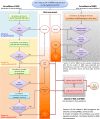Development of guidelines for the surveillance of invasive mosquitoes in Europe
- PMID: 23866915
- PMCID: PMC3724590
- DOI: 10.1186/1756-3305-6-209
Development of guidelines for the surveillance of invasive mosquitoes in Europe
Abstract
Background: The recent notifications of autochthonous cases of dengue and chikungunya in Europe prove that the region is vulnerable to these diseases in areas where known mosquito vectors (Aedes albopictus and Aedes aegypti) are present. Strengthening surveillance of these species as well as other invasive container-breeding aedine mosquito species such as Aedes atropalpus, Aedes japonicus, Aedes koreicus and Aedes triseriatus is therefore required. In order to support and harmonize surveillance activities in Europe, the European Centre for Disease Prevention and Control (ECDC) launched the production of 'Guidelines for the surveillance of invasive mosquitoes in Europe'. This article describes these guidelines in the context of the key issues surrounding invasive mosquitoes surveillance in Europe.
Methods: Based on an open call for tender, ECDC granted a pan-European expert team to write the guidelines draft. It content is founded on published and grey literature, contractor's expert knowledge, as well as appropriate field missions. Entomologists, public health experts and end users from 17 EU/EEA and neighbouring countries contributed to a reviewing and validation process. The final version of the guidelines was edited by ECDC (Additional file 1).
Results: The guidelines describe all procedures to be applied for the surveillance of invasive mosquito species. The first part addresses strategic issues and options to be taken by the stakeholders for the decision-making process, according to the aim and scope of surveillance, its organisation and management. As the strategy to be developed needs to be adapted to the local situation, three likely scenarios are proposed. The second part addresses all operational issues and suggests options for the activities to be implemented, i.e. key procedures for field surveillance of invasive mosquito species, methods of identification of these mosquitoes, key and optional procedures for field collection of population parameters, pathogen screening, and environmental parameters. In addition, methods for data management and analysis are recommended, as well as strategies for data dissemination and mapping. Finally, the third part provides information and support for cost estimates of the planned programmes and for the evaluation of the applied surveillance process.
Conclusion: The 'Guidelines for the surveillance of invasive mosquitoes in Europe' aim at supporting the implementation of tailored surveillance of invasive mosquito species of public health importance. They are intended to provide support to professionals involved in mosquito surveillance or control, decision/policy makers, stakeholders in public health and non-experts in mosquito surveillance. Surveillance also aims to support control of mosquito-borne diseases, including integrated vector control, and the guidelines are therefore part of a tool set for managing mosquito-borne disease risk in Europe.
Figures





References
-
- European Centre for Disease Prevention and Control (ECDC) Consultation on mosquito-borne disease transmission risk in Europe. Paris, 26 November 2010. Stockholm: ECDC; 2011. (ECDC Meeting Report). http://ecdc.europa.eu/en/publications/Publications/1102_MER_Consultation....
-
- Angelini R, Finarelli AC, Angelini P, Po C, Petropulacos K, Silvi G, Macini P, Fortuna C, Venturi G, Magurano F, Fiorentini C, Marchi A, Benedetti E, Bucci P, Boros S, Romi R, Majori G, Ciufolini MG, Nicoletti L, Rezza G, Cassone A. Chikungunya in north-eastern Italy: a summing up of the outbreak. Euro Surveill. 2007;12(47):3313. - PubMed
-
- La Ruche G, Souares Y, Armengaud A, Peloux-Petiot F, Delaunay P, Despres P, Lenglet A, Jourdain F, Leparc-Goffart I, Charlet F, Ollier L, Mantey K, Mollet T, Fournier JP, Torrents R, Leitmeyer K, Hilairet P, Zeller H, Van Bortel W, Dejour-Salamanca D, Grandadam M, Gastellu-Etchegorry M. First two autochthonous dengue virus infections in metropolitan France, September 2010. Euro Surveill. 2010;15(39):19676. - PubMed
-
- Gjenero-Margan I, Aleraj B, Krajcar D, Lesnikar V, Klobucar A, Pem-Novosel I, Kurecic-Filipovic S, Komparak S, Martic R, Duricic S, Betica-Radic L, Okmadzic J, Vilibic-Cavlek T, Babic-Erceg A, Turkovic B, Avsic-Zupanc T, Radic I, Ljubic M, Sarac K, Benic N, Mlinaric-Galinovic G. Autochthonous dengue fever in Croatia, August-September 2010. Euro Surveill. 2011;16(9):19805. - PubMed
MeSH terms
LinkOut - more resources
Full Text Sources
Other Literature Sources
Research Materials
Miscellaneous

